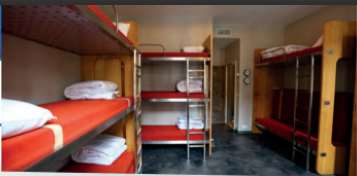5. Make a presentation of your ideal city using your answers in Exercise 4.
(Hãy trình bày về thành phố lý tưởng của bạn bằng cách sử dụng các câu trả lời ở Bài tập 4.)
In my vision of the ideal city in 2050, we're looking at a truly transformative urban landscape. Transportation will be at the forefront of this revolution. Residents will have a diverse array of advanced options at their fingertips, including electric vehicles, self-driving cars, and even drone buses. This not only promises efficiency in movement but also a significant reduction in environmental impact.
But it's not just about getting from point A to point B. The city will be a green oasis within the urban sprawl. Rooftop gardens, terraces for plant cultivation, vertical farms, and "green walls" integrated into buildings will bring nature closer to home. Central parks with tall trees will provide a sanctuary for relaxation and recreation, offering a breath of fresh air in the heart of the city.
Technological marvels will be woven seamlessly into the city's fabric. Automatic sensors will constantly monitor pollution levels and traffic conditions, allowing for swift and efficient city management. A comprehensive charging infrastructure will support the widespread use of electric vehicles, leading to a cleaner and healthier urban environment. Smart buildings will optimize energy use and ensure a comfortable living environment for all residents.
Living in this ideal city will offer an unparalleled level of comfort and quality of life. Transportation systems will be efficient, reducing commute times and congestion, and providing more time for leisure and activities. The clean environment, with improved air quality, will promote better health and well-being. Advanced technology and data-driven city management will ensure a high standard of living.
Community engagement will be central to the city's ethos. Residents will actively participate in initiatives like urban farming and environmental conservation, creating a strong sense of belonging and pride. Sustainability will be the backbone of the city's development, guaranteeing a bright future for generations to come.
In conclusion, the ideal city of 2050 is a harmonious blend of innovation, sustainability, and quality of life. It's a city that not only meets the needs of its inhabitants but also safeguards the environment for future generations. It's a city we can all aspire to call home.
Tạm dịch
Trong tầm nhìn của tôi về thành phố lý tưởng vào năm 2050, chúng tôi đang nhìn vào một cảnh quan đô thị thực sự có tính biến đổi. Giao thông vận tải sẽ đi đầu trong cuộc cách mạng này. Cư dân sẽ có nhiều lựa chọn nâng cao trong tầm tay, bao gồm xe điện, ô tô tự lái và thậm chí cả xe buýt không người lái. Điều này không chỉ hứa hẹn hiệu quả trong việc di chuyển mà còn giảm đáng kể tác động đến môi trường.
Nhưng vấn đề không chỉ là đi từ điểm A đến điểm B. Thành phố sẽ là một ốc đảo xanh trong khu đô thị mở rộng. Những khu vườn trên mái, sân thượng để trồng cây, trang trại thẳng đứng và những “bức tường xanh” được tích hợp vào các tòa nhà sẽ mang thiên nhiên đến gần nhà hơn. Các công viên trung tâm với những hàng cây cao sẽ là nơi trú ẩn thư giãn, giải trí, mang đến hơi thở không khí trong lành giữa lòng thành phố.
Những tuyệt tác công nghệ sẽ được dệt liền mạch vào cơ cấu của thành phố. Cảm biến tự động sẽ liên tục theo dõi mức độ ô nhiễm và điều kiện giao thông, cho phép quản lý thành phố nhanh chóng và hiệu quả. Cơ sở hạ tầng sạc toàn diện sẽ hỗ trợ việc sử dụng rộng rãi xe điện, mang lại môi trường đô thị sạch hơn và trong lành hơn. Tòa nhà thông minh sẽ tối ưu hóa việc sử dụng năng lượng và đảm bảo môi trường sống thoải mái cho mọi cư dân.
Sống ở thành phố lý tưởng này sẽ mang lại mức độ thoải mái và chất lượng cuộc sống tuyệt vời. Hệ thống giao thông vận tải sẽ hoạt động hiệu quả, giảm thời gian đi lại và tắc nghẽn, đồng thời mang lại nhiều thời gian hơn cho hoạt động và giải trí. Môi trường sạch sẽ, chất lượng không khí được cải thiện sẽ mang lại sức khỏe và tinh thần tốt hơn. Công nghệ tiên tiến và quản lý thành phố dựa trên dữ liệu sẽ đảm bảo mức sống cao.
Sự tham gia của cộng đồng sẽ là trọng tâm trong đặc tính của thành phố. Người dân sẽ tích cực tham gia vào các sáng kiến như nông nghiệp đô thị và bảo tồn môi trường, tạo ra cảm giác thân thuộc và niềm tự hào mạnh mẽ. Tính bền vững sẽ là xương sống cho sự phát triển của thành phố, đảm bảo một tương lai tươi sáng cho các thế hệ mai sau.
Tóm lại, thành phố lý tưởng vào năm 2050 là sự kết hợp hài hòa giữa sự đổi mới, tính bền vững và chất lượng cuộc sống. Đó là một thành phố không chỉ đáp ứng nhu cầu của người dân mà còn bảo vệ môi trường cho các thế hệ tương lai. Đó là một thành phố mà tất cả chúng ta đều khao khát được gọi là nhà.

Các bài tập cùng chuyên đề
3. Work in pairs. Talk about future developments in your neighbourhood. Use stative verbs in continuous form and linking verbs.
(Làm việc theo cặp. Nói về những phát triển trong tương lai trong khu phố của bạn. Sử dụng động từ trạng thái ở dạng tiếp diễn và động từ nối.)
Example: (Ví dụ)
A: The government is thinking of building a new skyscraper here.
(Chính phủ đang nghĩ đến việc xây dựng một tòa nhà chọc trời mới ở đây.)
B: Fantastic! Our city will look more modern.
(Tuyệt vời! Thành phố của chúng ta sẽ trông hiện đại hơn.)
Characteristics of future cities
(Những đặc điểm của các thành phố tương lai)
1. Work in groups. Discuss the questions.
(Làm việc nhóm. Thảo luận các câu hỏi.)
1. What will future cities look like?
(Các thành phố trong tương lai sẽ như thế nào?)
2. Do you think they will be ‘smarter’ and more sustainable? Why/Why not?
(Bạn có nghĩ rằng chúng sẽ 'thông minh hơn' và bền vững hơn không? Tại sao/Tại sao không?)
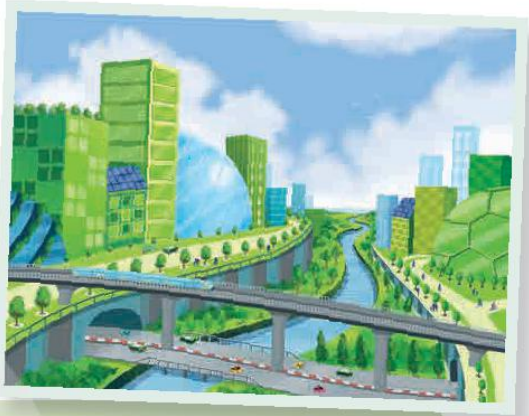
5. Work in groups. Discuss the following questions.
(Làm việc nhóm. Thảo luận các câu hỏi sau.)
Would you like to live in a smart and sustainable city? Why/Why not?
(Bạn có muốn sống trong một thành phố thông minh và bền vững? Tại sao có? / Tại sao không?)
Discussing cities in the future
(Thảo luận về các thành phố trong tương lai)
1. Work in pairs. Complete the diagram with the ideas below.
(Làm việc theo cặp. Hoàn thành sơ đồ với những ý tưởng dưới đây.)
A. Quality of life will be improved thanks to the cleaner environment.
(Chất lượng cuộc sống sẽ được cải thiện nhờ môi trường trong sạch hơn.)
B. There will be no private vehicles because people will use public transport.
(Sẽ không có phương tiện cá nhân vì mọi người sẽ sử dụng phương tiện giao thông công cộng.)
C. Green skyscrapers will replace old blocks of flats and offices in crowded urban centres.
(Các tòa nhà chọc trời xanh sẽ thay thế các dãy nhà và văn phòng cũ ở các trung tâm đô thị đông đúc.)
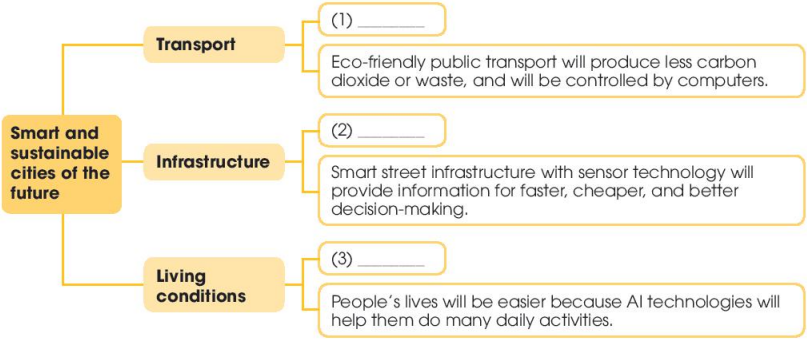
2. Match the questions with the answers to make a conversation. Then practice it in pairs.
(Nối các câu hỏi với các câu trả lời để tạo thành một đoạn hội thoại. Sau đó thực hành nó theo cặp.)
|
1. What do you think transport will be like in the cities of the future? |
a. They will use public transport instead of their own vehicles. |
|
2. So, how will people travel in the city? |
b. Because technology will make public transport faster, more convenient, and more eco-friendly. |
|
3. Really? Why do you think public transport will be popular with city dwellers? |
c. Well, I think there will be no private vehicles in the cities. |
3. Work in pairs. Ask and answer questions about one of the features of future cities in 1. Use the model and the tips in 2 to help you.
(Làm việc theo cặp. Hỏi và trả lời các câu hỏi về một trong những đặc điểm của các thành phố trong tương lai trong phần 1. Sử dụng mô hình và các mẹo trong phần 2 để giúp bạn.)
4. Work in groups. Discuss what the cities of the future will be like and present your groups’ ideas to the whole class.
(Làm việc nhóm. Thảo luận về các thành phố trong tương lai sẽ như thế nào và trình bày ý tưởng của nhóm bạn trước cả lớp.)
4. Work in groups. Discuss the following questions.
(Làm việc nhóm. Thảo luận các câu hỏi sau.)
Do you agree with Ms Stevens? Which of the disadvantages she mentioned do you think is the most serious? Why?
(Bạn có đồng ý với cô Stevens không? Bạn nghĩ nhược điểm nào trong số những nhược điểm mà cô ấy đề cập là nghiêm trọng nhất? Tại sao?)
2. Work in groups. Discuss the following questions.
(Làm việc nhóm. Thảo luận các câu hỏi sau.)
Which of the technologies in the text would you like to have in your city or neighbourhood? Why?
(Bạn muốn có công nghệ nào trong văn bản trong thành phố hoặc vùng lân cận của mình? Tại sao?)
The ideal city of the future
(Thành phố lý tưởng của tương lai)
Work in groups. Design a poster of the ideal city of the future. Present your poster to the class. Use these questions as cues for your presentation.
(Làm việc theo nhóm. Thiết kế một tấm áp phích về thành phố lý tưởng trong tương lai. Trình bày tấm áp phích của bạn trước lớp. Sử dụng những câu hỏi này làm gợi ý cho phần trình bày của bạn.)
Where will it be located? (Nó sẽ được đặt ở đâu?)
How big will it be? (Nó sẽ lớn như thế nào?)
How many people will live in it? (Có bao nhiêu người sẽ sống trong đó?)
How will people travel? (Mọi người sẽ đi du lịch như thế nào?)
What kind of buildings will people live in? (Mọi người sẽ sống trong những tòa nhà nào?)
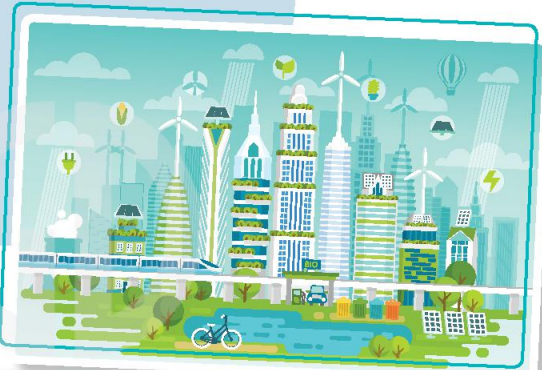
2. Work in groups. Compare your diagrams. Discuss which is the most important thing that will help people to live a long and healthy life in the cities of the future.
(Làm việc nhóm. So sánh sơ đồ của bạn. Thảo luận xem điều gì là quan trọng nhất sẽ giúp mọi người sống lâu và khỏe mạnh ở các thành phố trong tương lai.)
1 SPEAKING Do you love living in a city? What do you think are the benefits of living in a big city?
(Bạn có thích sống trong một thành phố? Bạn nghĩ những lợi ích của việc sống trong một thành phố lớn là gì?)
2 Work in pairs. Match the photos A-E with the cities and the countries. What do the countries have in common?
(Làm việc theo cặp. Nối các bức ảnh từ A-E với các thành phố và quốc gia. Các quốc gia có điểm gì chung?)
Cities

Countries

Photo D-Ha Noi - Viet Nam
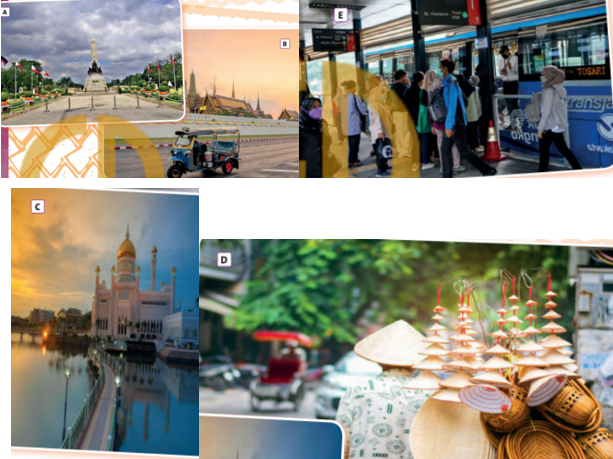
8 SPEAKING Which city in exercise 2 have you been to? Which city do you like to visit most? Why?
(Bạn đã đến thành phố nào trong bài tập 2? Thành phố nào bạn thích đến thăm nhất? Tại sao?)
1 SPEAKING Describe the photo. What are the people discussing, do you think?
(Mô tả bức ảnh. Mọi người đang thảo luận điều gì, bạn nghĩ sao?)
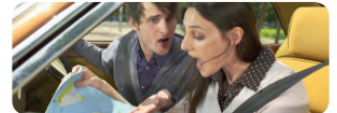
7 SPEAKING Work in pairs. Tell your partner about a journey on which you experienced travel problems, for example, a delay. What was the problem? How did it affect your journey?
(Làm việc theo cặp. Nói với đối tác của bạn về một hành trình mà bạn gặp phải sự cố khi đi lại, chẳng hạn như bị chậm trễ. Vấn đề là gì? Nó đã ảnh hưởng đến hành trình của bạn như thế nào?)
1 SPEAKING Work in pairs. Do you think space programmes, which cost millions, are a good way for governments to spend money? Give reasons.
(Làm việc theo cặp. Bạn có nghĩ rằng các chương trình không gian, cái mà tiêu tốn hàng triệu đô la, là một cách tốt để các chính phủ tiêu tiền không? Đưa ra lý do.)
5 SPEAKING Discuss the questions with your partner. Use the nouns and adjectives below to help you.
(Thảo luận các câu hỏi với bạn của bạn. Sử dụng các danh từ và tính từ dưới đây để giúp bạn.)
Nouns

Adjectives

1 What personal qualities do astronauts need?
(Phi hành gia cần những phẩm chất cá nhân nào?)
2 What would the best thing about the job be?
(Điều tốt nhất về công việc là gì?)
3 What would the hardest thing about the job be?
(Điều khó khăn nhất về công việc là gì?)
1 SPEAKING Describe the photo in pairs. What would be the best and worst things about going on a long trip on a boat like this?
(Mô tả bức ảnh theo cặp. Điều tốt nhất và tồi tệ nhất khi thực hiện một chuyến đi dài trên một chiếc thuyền như thế này là gì?)

2 Read the text. If you had been on a trip like this, would you have enjoyed it? Why? / Why not?
(Đọc văn bản. Nếu bạn đã có một chuyến đi như thế này, bạn có thích nó không? Tại sao có? / Tại sao không?)
When Jane and Clive Green stopped working, they decided to go on a trip to Spain in their yacht. They expected to be away for about a week - but in the end, they continued travelling for sixteen years! After they reached Spain in their ten-metre yacht, they did not fancy returning home, so they kept sailing. After crossing the Atlantic, they stopped to explore the islands of the Caribbean for a while. Then they continued to sail west around the world. They ended up visiting 56 countries. They particularly enjoyed swimming with seals near the Galápagos Islands. However, they remembered feeling very anxious near Somalia because a boat would not stop following them. It was actually a fishing boat with an injured man on board, so Jane offered to help him before they continued on their way. They managed to pay for their trip by selling their house back in the UK. They could afford to buy food, but they ran out of money on an island near Fiji. Fortunately, a local woman agreed to give them a box of fruit and vegetables in exchange for some clothes.
1 SPEAKING Are you good at learning new technologies? Do you know what 3G, 4G, app, IoT stand for?
(Bạn có giỏi học các công nghệ mới không? Bạn có biết 3G, 4G, app, loT là viết tắt của từ gì không?)
2 Look at the pictures and match them with the ideas below Look at the title of the text. Which of the ideas of future cities do you think are mentioned in the text?
(Nhìn vào những bức tranh và nối chúng với những ý tưởng bên dưới Nhìn vào tiêu đề của văn bản. Bạn nghĩ ý tưởng nào về các thành phố trong tương lai được đề cập trong văn bản?)
- Sky cities will be built with solar-run buildings.
- Internet will control every human activity.
- People will work in mobile offices.
- Underground trips will become safer and faster than ever.
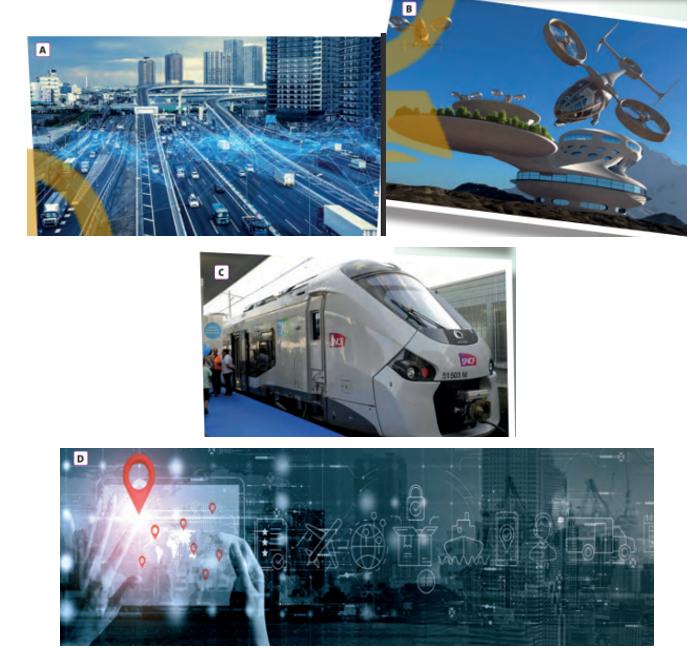
Go Autonomous - GO GREEN
Since the birth of the car in 1886, transport in big cities has changed a lot. And it is no wonder that many experts think that there will be extraordinary changes in the next few decades.
As technology develops, highways, skylines, subways will be all transformed. Smarter sroadways and highways in cities outfitted with loT sensors will process all kinds of data in real time and alert users of the best transport options. Weather, crashes, traffic conditions will be communicated to users and smart stops will be found everywhere providing renewable energy, green hydrogen or even greener energy, ensuring efficiency and safety on every highway. Tunnels will also be a smart choice 10 because of the reduction of traffic congestion. Underground roads will be built in 3D with a lift system which will take vehicles deep underground and will allow traffic to attain the greatest speed without intersections.
There will also be innovations in the sky. Air taxis are not a new idea, but in the future they will be completely environment-friendly. Aviation gasoline will be no longer used. Green energy will be in place and cost-effective air taxis will enable people to travel from one busy urban city to another in record time.
New technologies such as Al and the rollout of 5G will pave the way for fully autonomous innovation. Cars will not be the only thing to go autonomous. Freight trucks, cargo vehicles, air taxis will all benefit from this technology and that is why 20 the term 'driver' will become extinct.
Transport will go green. Electric or hydrogen power will be mainstream. There will still be issues to solve such as safety, speed and cost, and of course governments will need to make new traffic laws.
6 SPEAKING Work in pairs. Discuss the following questions.
(Làm việc theo cặp. Thảo luận các câu hỏi sau.)
-What do you think is the biggest problem when building smart tunnels?
(-Theo bạn vấn đề lớn nhất khi xây dựng đường hầm thông minh là gì?)
- How many years may it take to put air taxis into popular use?
(- Phải mất bao nhiêu năm taxi hàng không mới được sử dụng phổ biến?)
1 Describe the photo and answer the questions below.
(Miêu tả bức ảnh và trả lời các câu hỏi bên dưới.)
1 VOCABULARY Which of these activities are likely to be on offer at or near this location? Where could you do the others?
(Hoạt động nào trong số những hoạt động này có khả năng được cung cấp tại hoặc gần địa điểm này? Bạn có thể làm những việc khác ở đâu?)

Holiday activities

2 Would you prefer to be on holiday here or in an expensive hotel in a city? Give reasons.
(Bạn muốn đi nghỉ ở đây hay ở một khách sạn đắt tiền trong thành phố? Đưa ra lý do.)
Speaking Strategy
Use your preparation time to read the task carefully. Make sure that you understand each of the points that you need to discuss. If you have time, think of two or three key pieces of information or vocabulary connected with each topic.
(Chiến lược nói
Sử dụng thời gian chuẩn bị của bạn để đọc nhiệm vụ một cách cẩn thận. Hãy chắc chắn rằng bạn hiểu từng mục mà bạn cần thảo luận. Nếu bạn có thời gian, hãy nghĩ về hai hoặc ba thông tin hoặc từ vựng chính liên quan đến mỗi chủ đề.)
2 Read the Speaking Strategy. Then read the task below. Match the following (1-8) with the four points in the task. Use them to discuss with a friend.
(Đọc Chiến lược nói. Sau đó đọc nhiệm vụ dưới đây. Ghép phần sau (1-8) với bốn mục trong nhiệm vụ. Sử dụng chúng để thảo luận với một người bạn.)
1 a job: công việc
2 a month of the year: một tháng trong năm
3 a popular tourist area: khu du lịch nổi tiếng
4 buses and trains: xe buýt và xe lửa
5 a week/a fortnight: một tuần / hai tuần
6 borrowing/lending: mượn / cho mượn
7 youth hostels: ký túc xá thanh niên
8 beaches and the sea: bãi biển và biển
You are planning to go on holiday with friends this summer. Discuss the holiday with one of the friends. Make a decision about each of these four points.
• When you want to go and for how long
• Choice of destination
• Transport
• Paying for the holiday
(Bạn đang lên kế hoạch đi nghỉ cùng bạn bè vào mùa hè này. Thảo luận về kỳ nghỉ với một trong những người bạn. Đưa ra quyết định về từng điểm trong số mục này.
• Khi nào bạn muốn đi và trong bao lâu
• Lựa chọn điểm đến
• Phương tiện
• Chi trả cho kỳ nghỉ)
5 VOCABULARY Work in pairs. Check the meaning of the words below. Then discuss which types of accommodation you prefer.
(Làm việc theo cặp. Kiểm tra ý nghĩa của các từ dưới đây. Sau đó thảo luận về loại chỗ ở mà bạn thích.)
Holiday accommodation

7 SPEAKING Work in pairs. Do the task in exercise 6. Decide who is playing which role. Make use of reply questions and question tags.
(Làm việc theo cặp. Thực hiện nhiệm vụ trong bài tập 6. Quyết định xem ai sẽ đóng vai nào. Sử dụng các câu hỏi trả lời và câu hỏi đuôi.)
1 SPEAKING Describe the photo. Have you ever stayed in a youth hostel? How are they different from hotels?
(Mô tả bức ảnh. Bạn đã bao giờ ở trong một ký túc xá thanh niên? Chúng khác với khách sạn như thế nào?)
